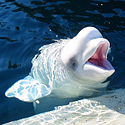 From Dr. Doolittle to Jane Goodall, human-animal communication has occupied our thoughts both in fiction and in reality. Dogs recognize their names when they are called; researchers have successfully taught primates to communicate in sign language; and the famed African gray parrot, Alex, built a vocabulary of over 100 English words out of which he learned to form cogent sentences. All of these examples show humans reaching out to communicate with animals, but what happens when animals try to speak with us?
From Dr. Doolittle to Jane Goodall, human-animal communication has occupied our thoughts both in fiction and in reality. Dogs recognize their names when they are called; researchers have successfully taught primates to communicate in sign language; and the famed African gray parrot, Alex, built a vocabulary of over 100 English words out of which he learned to form cogent sentences. All of these examples show humans reaching out to communicate with animals, but what happens when animals try to speak with us?
For the first time researchers have released a recording of the spontaneous impersonation of human speech out of the mouth. . . or spout of a beluga whale. The unexpected speaker was a cetacean (the scientific name for beluga whales) named NOC, residing in San Diego, California at the U.S. Navy Marine Mammal Program. After seven years under the care of researchers in the program, NOC began to produce vocalizations that sounded remarkably similar to human speech, but unlike dolphins or marine mammals in similar programs, NOC was never trained to do so.
Sam Ridgway, president of the National Marine Mammal Foundation, released a paper in Current Biology Magazine describing the odd mechanics NOC had to master in order to produce such human-like sounds. By applying pressure sensors to detect vibrations in NOC’s nasal passages, Ridgway concluded that NOC was using a structure that appears in dolphins and some whales known as “phonic lips.” The cetacean controlled this unlikely organ to mitigate the flow of sound out of his nasal cavity (the blowhole on top of his head) in the same way humans control their vocal chords.
Though NOC sadly passed away in 1999, his voice lives on in the recordings that have inspired this exciting new development in human-animal communication.
Give it a listen. What do you think NOC is saying?














